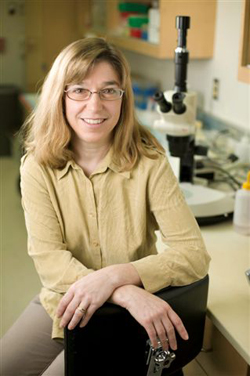 |
Gloria Borgstahl, Ph.D. |
NOTE: This profile is part of a series highlighting the 26 researchers who were named UNMC Distinguished Scientists or New Investigators for 2007. Each of these researchers will be profiled in UNMC Today leading up to a March 20 ceremony to recognize their achievements.
Name: Gloria Borgstahl, Ph.D.
Title: Associate Professor
Joined UNMC: 2002
Hometown: Dubuque, Iowa
Breifly describe your research in laymen terms.
We are interested in understanding the molecular basis of the chemistry of life. We use the tools of X-ray crystallography to “see” what these macromolecules look like and understand how they work.
|
I was an undergraduate student in biomedical engineering at the University of Iowa. At first I thought I wanted to go to medical school and then realized I didn’t want to be around sick people all the time. I didn’t feel I had the necessary people skills. Worse come to worse, I could be an engineer and make a decent living but that was too dry and boring for me. I took my first biochemistry class as a senior and performed my senior research project involving an animal model to study the biochemistry of lower back pain. Between these two things, I knew I never wanted to work with animal models ever again but I was hooked on trying to understand the “chemistry of life.” So I transferred from graduate studies in mechanical engineering to biochemistry, which means the medical side of the river in Iowa City. Once there, I was disappointed at the lack of math in biochemistry, for math was one of my best subjects and I really enjoyed it. Finally at the end of my first year I did my third lab rotation in X-ray crystallography, the perfect combination of biochemistry, physics and math, and — at the age of 24 — I finally figured out what to do with my life.
How do you see your research contributing to science?
When we visualize a never-before-seen protein molecule or macromolecular complex in three-dimensions, it is truly exciting — like seeing a new world. It is my hope that the fundamental work that we do will be used by other scientists in their biomedical studies to understand disease processes at the molecular level. Of course, my biggest hope is to someday contribute to the cure of disease.
Why did you become a scientist?
When I was growing up my dad had a subscription to the popular magazines Scientific American and National Geographic. When I was in high school, he encouraged me to take every science and math class that was offered. I have always been drawn to nature and to understand how things work. In the end, I think it was because I wanted to be able to do what monkeys could not.
What is your hope for the next generation of scientists?
I hope that the next generation will be able to pursue scientific questions just because they are fascinated and that through this delightful obsession that they will make great discoveries.
Beyond grant funding, how do you measure success?
By how well my students are doing in their research studies and careers and by how I feel at the end of the day. For example, the day I published one of my structures on the cover of Scientific American was a good day! I also feel great pride when a student gets a tough experiment to work, passes an exam, receives a fellowship, graduates and goes on to a new job.
What would you tell a student interested in a research career?
When you decide what to do to make a living, it is most important to spend your time doing what you love, as you would a hobby. This way you never have to “go to work,” you will make the most of your life and you will enjoy what you have. This is what a research career has given me.
Do you have a hero/role model? If so, what do you admire most about them?
I admire the women from the turn of the 20th century such as Dorothy Hodgkin. She didn’t think about the limitations of her gender and signed up for classes like chemistry and physics in school. Her biography shows her in the back row of a high school chemistry lab class. She is the only girl in the room and in a dress. She went on to become an X-ray crystallographer and won the Nobel Prize for her work on penicillin and insulin. She even became labeled as a communist sympathizer because she literally carried her model of insulin — in a suitcase — to China to share her data with collaborators. Besides all this, she was afflicted with rheumatoid arthritis at an early age and had her lab “handicap accessible.” She was amazing and admirable.
Tell us about your family and hobbies outside of the lab.
I have two children whom I adore. Margie is 12 now and on the honor roll in junior high school at Lewis and Clark. John is 9 and acing fourth grade at Dundee School. My hobbies are whatever they like to do and I’ve taught them to love RAGBRAI (a bicycle ride across the state of Iowa) and long distance bicycling. My son and I will be on a tandem this year, my daughter on her road bike.
List three things few people know about you.
- I grew up in a very happy family, the youngest of seven, living below the poverty level.
- My father was self employed and ran a janitorial service and we all worked for him from grade school on up. We had a lot of fun and called ourselves “Jerry’s Jolly Janitors.”
- I can clean a bathroom faster than anyone.